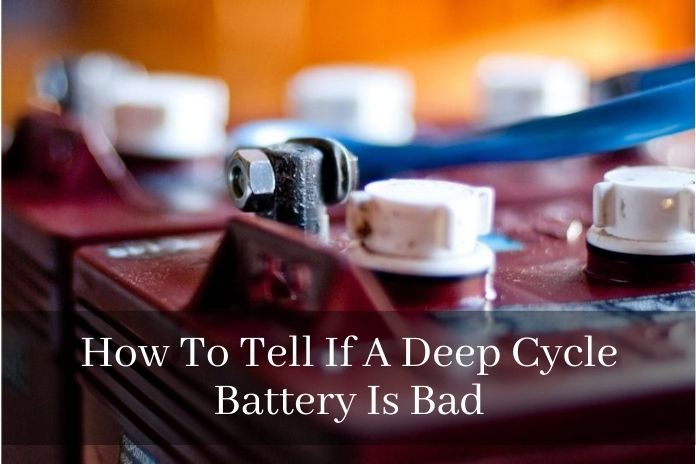
The “average joes” or ordinary people all know that batteries are used to power various electronic devices. Whether it is an electric vehicle like golf carts, smartphones, or a TV remote control, all they know is that they operate because of batteries.
They don’t know that batteries this equipment are designed with varying significant differences that make them suitable for different kinds of applications.
Deep cycle batteries are a perfect example of this, they may have similar appearance with automotive cells, but they actually are very different. These cells are specifically designed for sustainable power over more extended time durations, and they can be run down up to 80% of its capacity.
How to tell a deep cycle battery is bad? If you want to check if a deep cycle battery is bad, damaged, or dead, you can simply go to a professional and ask for help in exchange for a professional fee.
To save a good amount of money, you can do it yourself by carrying out a series of tests that will tell you if the battery is bad. It will start from the exterior where you have to carry out a thorough physical inspection on the battery, then proceed to its interior. After the physical examination, you will then proceed to check its voltage and then conclude with a load test.
Once the three-step is done, the results will keep you track of the obvious and the unnoticeable issues on the deep cycle battery, allowing you to take a closer look at the real situation and weigh things out and take the ideal step to address the issue.
The entire process is more straightforward said than done since it will take a lot of effort and time if you are going to do it yourself. It will also require you to be patient.
Deep cycle batteries come in various types, and these cells are classified according to the electrolyte each of them has within them. Due to this, every kind of cell has its distinct upkeep requirements, and addressing an issue may also be different.
However, how you can tell the battery is bad, regardless of its type, will be the same, making the three-tiered test I mentioned earlier a standard procedure.
3 Step Method to Tell if a Deep Cycle Battery Is Bad or Not
In case you are experiencing issues with a deep cycle battery like it doesn’t hold a charge anymore or it has an erratic performance. There’s a great chance that it has an issue within it. Unless that issue is addressed, your battery’s erratic behavior will continuously pest you in the long run.
The best way to avoid this is to get on it as soon as you have the time, and you will have to start on determining the real culprit behind it.
On my answer earlier, I just gave the essential details for the entire process on how you can tell if a deep cycle battery is bad.
Here I will expand what I’ve said and go through it with detailed information to provide a guide that you can follow.
Step 1. Conduct a Through Physical Inspection on the Battery
To determine if a deep cycle battery is bad, you have to kick out the process with a physical inspection, starting with its exterior. Damage on its casing or any other exposed component can lead to several issues that make its performance erratic.
Start inspecting the housing and look for cracks, signs of leakage, and discolorations. Then check its terminals and see if one of them or both of them are broken.
Broken battery terminals can trigger a short and will severely damage the battery. If a short circuit starts on a broken terminal, you will see some melting on the parts where it happened, and there may be some signs of burns.
In case you have noticed cracks or holes on the casing, it may be the reason for it does not work because physically damaged batteries are considered unsafe.
After a thorough inspection of the battery’s exterior, you haven’t found any damage that may cause it to stop working.
The issue might be triggered or created within the cell, which will bring you to the next step of the process. It is where you will check if it has the right amount of voltage within it.
Step 2. Carry Out a Voltage Test to See the How Much it Has
The second part of the process is where you will check if the battery still has the voltage rating to deliver enough power.
Before you carry out the voltage check, you have to make sure that the battery is fully charged. Charge it first and then let it rest for three to five hours once it reaches the 100% charge state.
You can carry out a voltage test in three different ways or using three different devices.
One is by using a digital multimeter, which is a more versatile device. The next one is by using a voltmeter, which is a tool specifically designed for it.
Finally, you can use an analog multimeter, which is a slightly out of date device. Regardless of what you use, they will provide you a reliable reading.
After the voltage test, you will have to take note of the result and then compare it to the table below to determine its actual state of charge.
The table below is just to highlight the essential details for the process; that’s why they are represented in 25% increments and grouped with a specific range.

Reading Highlights:
● If the result of the voltage test is 0, that means it’s dead due to a short circuit.
● In case the voltage can’t get over the 10.5-volt mark, it’s already and needs replacement.
● When the device reads 12.4 volts or less, but the charger indicates a full charge state, it means the battery is sulfated.
Step 3. Subject the Battery to a Load Test
Now for the final phase of the process, carry out load testing on the battery and see if it can still deliver power without fluctuations.
Voltage drops are often a sign of a failing battery, and learning if your battery does have it can be bad. To carry the load testing, the final phase of the process which will tell if a deep cycle cell is bad.
Take the battery and connect the prongs of the digital multimeter with their respective terminals on the battery. And then create a circuit with a single load. Hold the prongs connected with the two terminals of the cell and observe the reading on the meter.
Do this for at least thirty seconds or a minute to make sure that you are watching the behavior of voltage and get a more accurate observation.
Keep in mind that a good battery with a twelve-volt rating should consistently have a reading within 9.5 volts to 10.5 volts range if your meter has a different reading, somethings wrong with the battery.
In case the reading got within the range, then gradually drops, or if the voltage reading of the meter is instantly displayed as zero, there’s something wrong with the cell.
That is how the three-step method to tell if a deep cycle battery is bad or not done.
After the process, you can go through the readings and observations you noticed while doing the tests. Then, you can have a rough idea of what’s wrong with the battery from there.
As you go through it all, you will then have a conclusive answer to what is really wrong with the battery then take the necessary steps to get back on track.
Final Thoughts
Thanks for taking the time to read my guide, and I hope that it helped you addressing the issue or problem.
Again to refresh your mind, to tell if a deep cycle battery is bad, you have to troubleshoot it. Start with an inspection of its exterior, then see if its voltage checks out with its specified rating. And complete the process with a load test.





